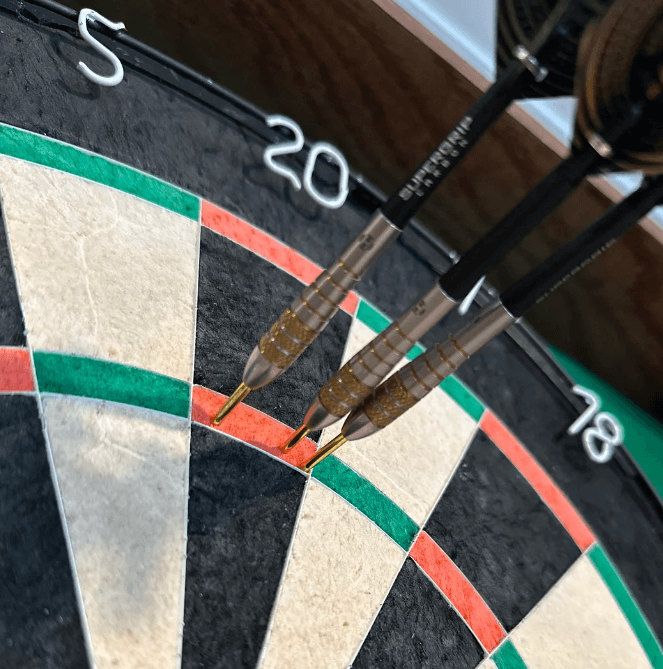Achieving a high score darts average is often the mark of a skilled player and a goal for anyone looking to elevate their game. Increasing your darts average requires a combination of consistency, practice, and technique.
In this guide, we’ll break down the most effective methods to elevate your scoring, covering strategies for aiming, technique improvement, mental focus, and practice routines. Whether you’re a seasoned player or new to the oche, these tips will help you maximize your scoring potential and reach higher averages.
1. Mastering the Fundamentals: Grip, Stance, and Release
- Grip: The way you hold the dart is foundational to your throw. Ensure you’re holding the dart with a relaxed but firm grip, using your thumb and two or three fingers. Too tight a grip can restrict your motion, while too loose a grip can lead to inconsistency.
- Stance: For a stable stance, stand sideways to the dartboard with your leading foot pointing slightly towards the board. This position gives you better balance and minimizes unnecessary movement, contributing to a consistent throw.
- Release: The release should be smooth and follow through towards the target. A controlled release helps maintain accuracy and rhythm, both of which are critical for maximizing your scoring average.
2. Aiming Techniques: Hitting Your Targets Consistently
- Focus on Consistency: Developing a consistent aim involves practicing with smaller target zones on the board. Aim at specific sections of the treble 20 (for higher scores) or other key numbers like 19 and 18 to get comfortable with high-scoring areas.
- Use Visual Aids: Some players find it helpful to focus on specific visual markers near the treble 20 or other scoring zones. By identifying these spots as secondary targets, you can train your eye to aim for consistent sections.
- Adjusting Your Line of Sight: Make sure that your dominant eye is lined up with the dart and the target. Adjusting your line of sight and how you approach the throw can refine your accuracy over time, leading to more consistent scores.

3. Practice Drills to Increase Scoring Accuracy
- Around the Clock: Practice hitting every number on the board, starting from 1 and moving up to 20. This drill encourages precision, making it easier to hit the numbers you need during actual gameplay.
- High Score Drill: Aim solely for high-value areas such as the treble 20 and bullseye. Set a goal of hitting the treble 20 at least five times in each round of practice. Over time, this focused practice helps develop accuracy in high-scoring zones.
- Bob’s 27: Start with a score of 27 and aim for doubles in sequence, beginning with double 1. For each successful double hit, add the double’s value to your score; for misses, subtract the value. This drill emphasizes accuracy under pressure and helps with scoring in competitive play.
4. Mental Game: Building Focus and Confidence
- Visualization: Before taking a throw, picture the dart hitting the exact spot you’re aiming for. Visualization improves focus and has been shown to help with accuracy by aligning your body’s movements with the mental image.
- Developing Resilience: Bad rounds can happen, but maintaining a positive attitude is key. Accept each round as an opportunity for improvement and avoid letting low scores affect your focus. Developing resilience in practice will translate to better performance under pressure.
- Routine Building: Establish a consistent pre-throw routine, whether it’s a breath, a stance reset, or another small ritual. A regular routine helps calm nerves and provides stability, making it easier to maintain focus, especially during high-stakes matches.
5. Scoring Strategies: When to Aim for the Bull vs. High-Score Numbers
- Go for the Treble 20: The treble 20 area is the highest-scoring zone on the board (worth 60 points per hit). Prioritizing this section can quickly elevate your average score, especially when you become proficient at hitting it regularly.
- The Bullseye Strategy: While the bullseye (50 points) is also high-value, its smaller target size makes it harder to hit consistently than the treble 20. Use the bull as a secondary target or when you’re comfortable with your scoring but want to challenge your accuracy.
- Utilize Treble 19 and Treble 18: If the treble 20 isn’t working for you during a round, try aiming for treble 19 (57 points) or treble 18 (54 points) as an alternative. These areas offer high points and are slightly easier to hit for some players.
6. Tracking Your Performance: Identify Weak Spots
- Score Tracking: Keep track of your average scores over time, paying attention to fluctuations. Apps like DartCounter and Darts Scorer can help you analyze your performance and spot trends in your scores.
- Video Review: Recording your practice sessions allows you to review and analyze your technique. Small adjustments to your stance, release, or aiming posture can be identified through video and adjusted accordingly.
- Regular Self-Evaluation: After each practice session, note any patterns. For example, if you consistently miss to the left, you may need to adjust your stance or release. This evaluation helps you make informed improvements to your game.
7. Setting Goals: Achievable Targets for Progressive Improvement
- Set Realistic Milestones: Break down larger goals into manageable milestones. Start with achievable targets, such as hitting treble 20 three times in a row, then gradually increase the difficulty.
- Compete Regularly: Entering competitions can improve your scoring by exposing you to high-pressure situations. Competing helps you track progress and adds a level of motivation to keep practicing and improving.
- Track Incremental Gains: Pay attention to your progress over time rather than focusing on immediate improvements. By tracking your journey and achieving small victories, you’ll stay motivated and steadily boost your scoring ability.

8. Optimizing Your Darts Setup
- Choose the Right Darts: Experiment with different weights and barrel styles to find the best fit for your throwing style. A comfortable dart setup contributes to consistency, which is essential for high scoring.
- Setting Up Your Practice Space: Ensure your practice area mimics a tournament setup, with a proper board height and distance. Familiarity with this setup allows you to focus on scoring without adjusting to new conditions.
- Regular Board Maintenance: Rotating the dartboard and cleaning it helps prevent wear in high-use areas like the 20 segment, keeping your scoring consistent.
9. Utilizing Technology to Track and Improve Scores
- Scoring Apps: Apps like DartConnect provide detailed stats and track your averages, checkouts, and consistency. Use these tools to identify areas of improvement.
- Smart Dartboards: Some electronic boards track scores in real-time and provide feedback, helping you adjust your throw based on instant scoring insights.
- Virtual Competitions: Competing online is a great way to simulate competition without leaving home, giving you practice in scoring and a chance to test new techniques against real opponents.
10. Pacing Your Practice: Quality Over Quantity
- Focused Sessions: Avoid marathon practice sessions, which can lead to fatigue and inconsistency. Instead, aim for shorter, focused sessions that allow you to retain accuracy and energy.
- Break Between Drills: Rest between high-intensity drills to ensure you maintain accuracy. These breaks prevent burnout and make each practice round productive.
- Tracking Fatigue Levels: Pay attention to your form as you practice; fatigue often leads to technical issues like poor stance and grip changes, which can negatively impact scoring.
Conclusion
Boosting your darts average is a journey that requires consistent practice, smart strategies, and mental resilience. By refining your technique, setting achievable goals, and employing scoring strategies, you can make steady progress and elevate your scoring potential. Embrace each practice session as an opportunity to improve, and with dedication, you’ll find your averages rising and your darts skills advancing to new heights.





